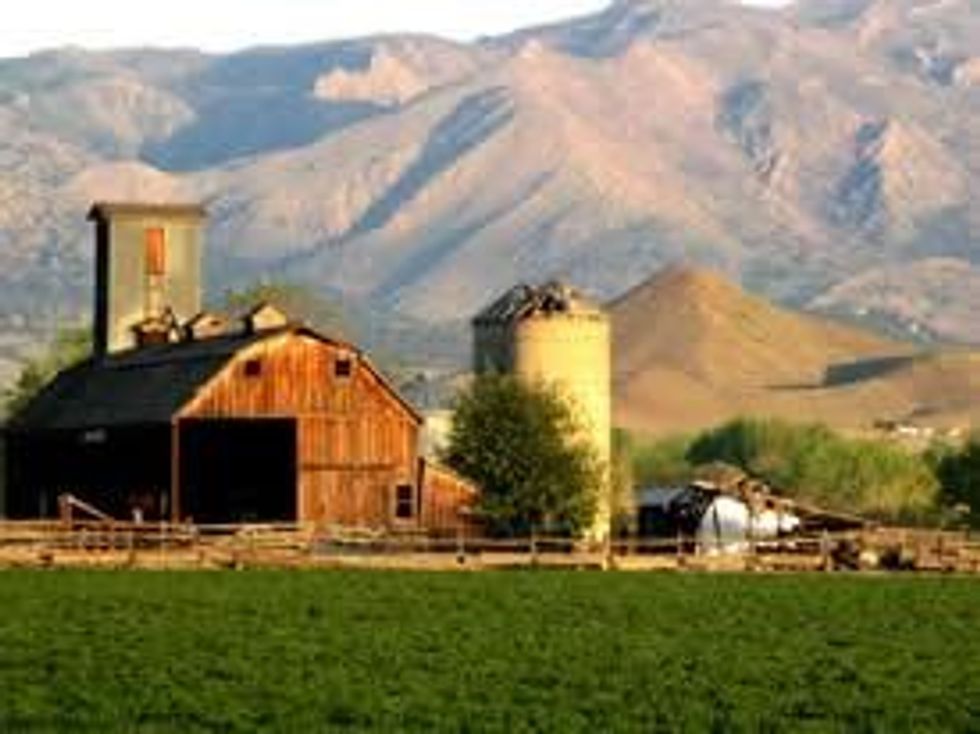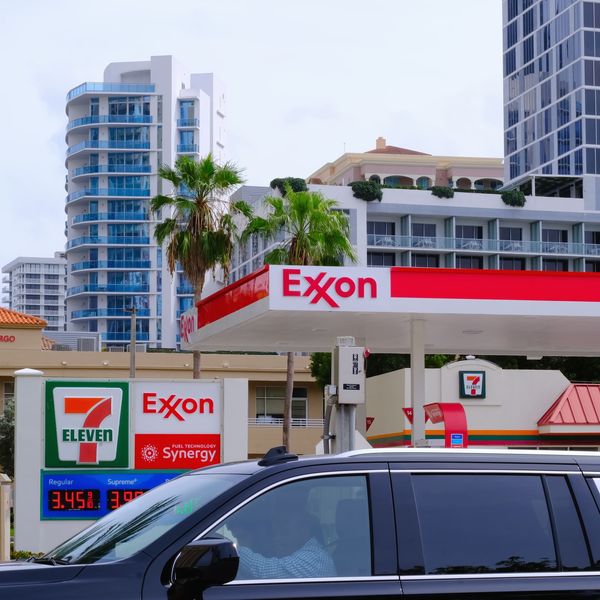Climate Insurance to Protect Our Food Supply?
With climate change making extreme weather the new normal, it's prudent to do everything we can to protect our food supply
I feel uneasy sleeping in a house without functioning smoke detectors. I lock my doors at night. I salt my sidewalk when it's icy. I always wear my seatbelt. Like most people, I prefer to minimize my chances of getting hurt or wrecking my car or house, despite the fact that my house, my car, and my health are all (thankfully) insured.

Unfortunately, most agriculture lobbyists are too single-minded as they try to influence the soon-to-be-written 2012 Farm Bill. Several farm state legislators, aligned with commodity groups like the American Soybean Association, are advocating for what are called "shallow-loss" revenue insurance programs, in which up to 95 percent of farmers' revenue is guaranteed. But in this push to give farmers unprecedented levels of financial risk avoidance, there has been no mention of the need to help farmers prevent crop and livestock losses in the first place.
Farmers have always been at the mercy of the weather, which is why the federal government has offered subsidized crop insurance since the late 1930s. This kind of income insurance is critical to help keep farmers on the land, but our food supply needs insurance, too.
Right now, there are no requirements for farmers receiving subsidized crop insurance to comply with even the most minimal conservation measures that would help keep topsoil from washing away during floods, much less are they required or even encouraged to adopt farming practices that might help them avoid losing fields of food when extreme weather hits. This puts not only our food supply, but also taxpayers' pocketbooks, at risk. There is currently no limit on how much the federal government can spend on crop insurance payouts, and none proposed if insurance programs are expanded.
There are ways to make agriculture more resilient to extreme weather. Farmers can plant more perennial crops, which require less water and hold on better to soil during floods. In drought-prone regions, they can select drought-tolerant crop varieties or change grazing or irrigation methods, among other strategies. In the same way that I get a lower car insurance rate because my car has airbags, we must encourage farmers to adopt measures like these to reduce risk on the ground. Taking steps to make food production more stable in the face of climate change is good for farmers and for taxpayers.
It's clear from the more than $11 billion the federal government spent on crop insurance in 2011 that our country values keeping farmers in business. If we also value our food supply, we need to couple crop insurance with "climate insurance" to make sure that in the wake of the next round of floods and droughts, our food is safe, and so are our farmers.
An Urgent Message From Our Co-Founder
Dear Common Dreams reader, The U.S. is on a fast track to authoritarianism like nothing I've ever seen. Meanwhile, corporate news outlets are utterly capitulating to Trump, twisting their coverage to avoid drawing his ire while lining up to stuff cash in his pockets. That's why I believe that Common Dreams is doing the best and most consequential reporting that we've ever done. Our small but mighty team is a progressive reporting powerhouse, covering the news every day that the corporate media never will. Our mission has always been simple: To inform. To inspire. And to ignite change for the common good. Now here's the key piece that I want all our readers to understand: None of this would be possible without your financial support. That's not just some fundraising cliche. It's the absolute and literal truth. We don't accept corporate advertising and never will. We don't have a paywall because we don't think people should be blocked from critical news based on their ability to pay. Everything we do is funded by the donations of readers like you. Will you donate now to help power the nonprofit, independent reporting of Common Dreams? Thank you for being a vital member of our community. Together, we can keep independent journalism alive when it’s needed most. - Craig Brown, Co-founder |
I feel uneasy sleeping in a house without functioning smoke detectors. I lock my doors at night. I salt my sidewalk when it's icy. I always wear my seatbelt. Like most people, I prefer to minimize my chances of getting hurt or wrecking my car or house, despite the fact that my house, my car, and my health are all (thankfully) insured.

Unfortunately, most agriculture lobbyists are too single-minded as they try to influence the soon-to-be-written 2012 Farm Bill. Several farm state legislators, aligned with commodity groups like the American Soybean Association, are advocating for what are called "shallow-loss" revenue insurance programs, in which up to 95 percent of farmers' revenue is guaranteed. But in this push to give farmers unprecedented levels of financial risk avoidance, there has been no mention of the need to help farmers prevent crop and livestock losses in the first place.
Farmers have always been at the mercy of the weather, which is why the federal government has offered subsidized crop insurance since the late 1930s. This kind of income insurance is critical to help keep farmers on the land, but our food supply needs insurance, too.
Right now, there are no requirements for farmers receiving subsidized crop insurance to comply with even the most minimal conservation measures that would help keep topsoil from washing away during floods, much less are they required or even encouraged to adopt farming practices that might help them avoid losing fields of food when extreme weather hits. This puts not only our food supply, but also taxpayers' pocketbooks, at risk. There is currently no limit on how much the federal government can spend on crop insurance payouts, and none proposed if insurance programs are expanded.
There are ways to make agriculture more resilient to extreme weather. Farmers can plant more perennial crops, which require less water and hold on better to soil during floods. In drought-prone regions, they can select drought-tolerant crop varieties or change grazing or irrigation methods, among other strategies. In the same way that I get a lower car insurance rate because my car has airbags, we must encourage farmers to adopt measures like these to reduce risk on the ground. Taking steps to make food production more stable in the face of climate change is good for farmers and for taxpayers.
It's clear from the more than $11 billion the federal government spent on crop insurance in 2011 that our country values keeping farmers in business. If we also value our food supply, we need to couple crop insurance with "climate insurance" to make sure that in the wake of the next round of floods and droughts, our food is safe, and so are our farmers.
I feel uneasy sleeping in a house without functioning smoke detectors. I lock my doors at night. I salt my sidewalk when it's icy. I always wear my seatbelt. Like most people, I prefer to minimize my chances of getting hurt or wrecking my car or house, despite the fact that my house, my car, and my health are all (thankfully) insured.

Unfortunately, most agriculture lobbyists are too single-minded as they try to influence the soon-to-be-written 2012 Farm Bill. Several farm state legislators, aligned with commodity groups like the American Soybean Association, are advocating for what are called "shallow-loss" revenue insurance programs, in which up to 95 percent of farmers' revenue is guaranteed. But in this push to give farmers unprecedented levels of financial risk avoidance, there has been no mention of the need to help farmers prevent crop and livestock losses in the first place.
Farmers have always been at the mercy of the weather, which is why the federal government has offered subsidized crop insurance since the late 1930s. This kind of income insurance is critical to help keep farmers on the land, but our food supply needs insurance, too.
Right now, there are no requirements for farmers receiving subsidized crop insurance to comply with even the most minimal conservation measures that would help keep topsoil from washing away during floods, much less are they required or even encouraged to adopt farming practices that might help them avoid losing fields of food when extreme weather hits. This puts not only our food supply, but also taxpayers' pocketbooks, at risk. There is currently no limit on how much the federal government can spend on crop insurance payouts, and none proposed if insurance programs are expanded.
There are ways to make agriculture more resilient to extreme weather. Farmers can plant more perennial crops, which require less water and hold on better to soil during floods. In drought-prone regions, they can select drought-tolerant crop varieties or change grazing or irrigation methods, among other strategies. In the same way that I get a lower car insurance rate because my car has airbags, we must encourage farmers to adopt measures like these to reduce risk on the ground. Taking steps to make food production more stable in the face of climate change is good for farmers and for taxpayers.
It's clear from the more than $11 billion the federal government spent on crop insurance in 2011 that our country values keeping farmers in business. If we also value our food supply, we need to couple crop insurance with "climate insurance" to make sure that in the wake of the next round of floods and droughts, our food is safe, and so are our farmers.

